Won the battle of a lost war - Lepanto 1571
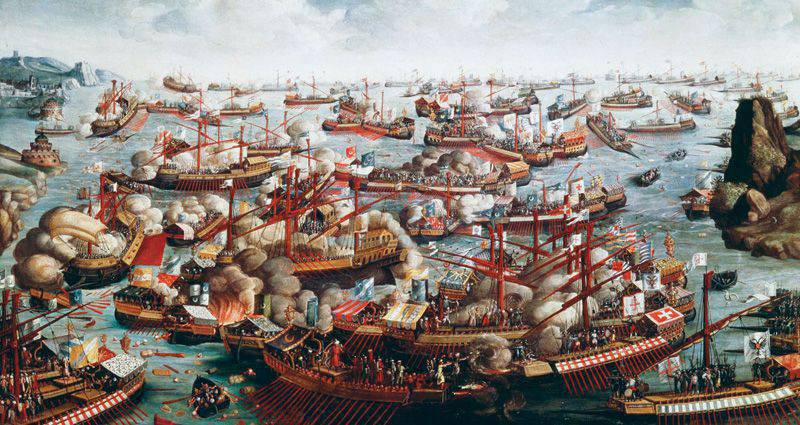
6 September 1566, when Turkish janissaries went to storm the small town of Sziget (later known as Shigetwar), Suleiman the Magnificent died on his way between Belgrade and Vienna to the battle of his famous drums. The bright era of the reign of one of the most famous rulers of the Ottoman Empire ended. After conducting 73 military companies, personally participating in each, the old warrior died of disease and old age. The Janissaries took Sighet, in the dark, that their leader was no longer alive. Personally devoted to the deceased sultan, the Grand Vizier Sokollu Mehmed Pasha hid from the army for several days the news that Suleiman was no more, sending messengers to Istanbul. The news that was transmitted in time allowed Selim, the son of the Sultan from his beloved wife Hurrem, to establish himself on the throne and take full power in the country. It is the chain of decisions made by the new ruler, known in stories as Selim II the Drunkard, and his entourage, led to the largest naval battle of the late Middle Ages - the battle of Lepanto.
It would be gold in the purse, and we are not afraid of clouds
By the end of the XNUMXth century, the Ottoman Empire was at the peak of its power and had virtually no enemies in the eastern Mediterranean basin. She possessed all the proper tools to satisfy her foreign policy ambitions: a huge, well-trained army and a large naval fleet. The opposing Christian states not only could not form even a miserable semblance of any coalition, but they were also busy trying to sort things out among themselves. The Holy Roman Empire was actually a huge gathering of small German states. Mighty Spain fought with France for control of Italy, the result was the battle of Pavia (1525), the defeat of the French and the capture of King Francis I. After that, the losers took up growing domestic problems. The Spanish monarchy, absorbed in the development of the recently opened New World, was paying less and less attention to Mediterranean problems. The safe crossing of the Atlantic with ships loaded with gold and silver was an increasingly important factor in the well-being of Madrid. Another major political player of the time - the Venetian Republic - tried hard not to quarrel with the Turks, turned a blind eye to the frequent captures of the Barbarian pirates, vassals of Istanbul, their ships and other similar dirty tricks. All the wealth of the Venetians was based on maritime communications and the ability to receive goods from the East.
In 1565, the Turks embark on a military expedition against the island of Malta, but suffer a painful setback. The very fact of the appearance of the Ottoman fleet in the center of the Mediterranean Sea and the growing excesses of the Algerian and Tunisian pirates began to cause concern "among pragmatic people who follow politics." In 1566, Pius V became the new Pope, who was considered to be a pious man, who at the same time considered the restoration of Christian control over the Mediterranean as the most important task and put a lot of effort into creating a coalition called the Holy League.
The enthusiasm of the new pontiff initially did not find support. Austrian Archduke Maximilian II adhered to peace signed with the Ottomans, the south of Spain was seized by an uprising of the Moriscos (as the Arabs were left who remained on the territory of the Iberian Peninsula and adopted Christianity for one reason or another). The Republic of Venice didn’t want any cloudiness on the horizon at all - the basis of its existence was based on the slogan: calm trade is above all. But, as Rudyard Kipling accurately noted, there is one among metals that “rules over everything”, even gold, - cold iron, which will soon again say its weighty word.
Is it time to warm up a little? or island on fire
Fortified on the throne, Selim inherited from his father only military ambitions, but not the talent of a military leader. He strove for paternal glory, not possessing any talents that were any noticeable to achieve it. The tempestuous temper craved for activity, and the new sultan began to consult with those close to him on the topic “Where would we war?”. Grand Vizier Sokollu Mehmed Pasha, to whom Selim delegated such a troublesome thing as governing the state, insisted on hitting Spain, which was occupied by the suppression of the Moriscos uprising. The sudden transfer to the Pyrenees (with emphasis on the North African coast, controlled by the Berbers) of a large army, which the rebels would gladly replenish, would create, in his opinion, a mortal danger to the Habsburg monarchy. But Selim did not dare to undertake such a large-scale expedition, but instead oriented the Vizier towards something closer. Closer were the Venetian colonies, namely the island of Cyprus, which is already in the depths of the Turkish possessions. However, in relations with the Venetians there was such an uncomfortable thing as a peace treaty. Needed a reason. To which the ruler, who wants to make war, will not do anything! As a casus belli, a tough argument was put forward: since the Orthodox Arabs had already possessed the island twice, it simply needs to be freed from enemy occupation. Mufti Ibn Said, with the suggestion of Selim, prepared for this purpose an “ideological platform” in the form of a corresponding firm.
The commander of the fleet and the whole expedition of Piali Pasha guaranteed the success of the enterprise. And not without reason. In 1569, a large fire caused enormous damage to the Venetian Arsenal, while Cyprus itself was located at a distance of 2 thousand km from the metropolis. In February 1570, the Sultan Selim declares a holy war against the infidels. 1 July 1570, the 56-thousandth Turkish army landed in Cyprus.
Cyprus Governor Niccolo Dandolo could oppose such hordes of no more than 10 thousand people and considered the battle in open areas impossible. The Venetians took refuge in the well-fortified capital of Nicosia and in the small town of Famagusta. High-speed vessels were sent to the metropolis asking for help. The news of the Turkish landing in Cyprus caught the trade republic off guard. 3 September 1570, Nicosia fell. New fortifications and bastions, for which huge funds were spent, did not help. Having failed in two assaults and in the digging of digging, the Turks launched an attack around the perimeter of the walls, preventing the enemy from maneuvering reserves. The garrison was almost completely killed, the inhabitants were partially destroyed, partially sold into slavery. Famagusta, with its old walls, was surprisingly strong. Stony soil prevented large-scale siege work, and at first the Turks confined themselves to blocking the fortress. The garrison commander Marco Antonio Bragadino skillfully led the defense, even managing to organize the breakthrough of several galleys from the harbor asking for help.
Dad speaks convincingly
Of course, Venice alone, despite its financial capabilities and powerful fleet, could not withstand all the power of the Ottoman Empire - there was too much difference in the weight category. The active 85 Venetian doge Alvise I Mocenigo begins major foreign policy activities in search of allies. Ambassadors and emissaries are sent to the capitals of European states to carry out probing on the subject of "help than you can." At first, the mission of the Venetian diplomats was more like the hardships of Gaufovsky Little Flour - they were attentively listened, nodded sympathetically, let in sincere tears, but at the same time complained about hard times and advised to turn to someone else. Indeed, the very recent scornful, even negative, attitude of Venice itself to possible anti-Turkish “sanctions” was well known because of the threat of losing profits from trade. Now circumstances have taken the "trading corporation" from the Adriatic Sea by the throat.
The situation changed when energetic Pius V took over all the organizational issues, who, in order to give the anti-Turkish coalition a greater momentum, engaged in sending out instructive letters: “Would you be kind enough ...” Especially the pontiff succeeded in eloquence at Philip II, King of Spain. He appealed to the religious feelings of the monarch, called to recall the glorious deeds of the kings of the Reconquista period. And in general, he made it clear in his ornate expressions that while the ships of the Muslim barbarians plow the expanses of the Mediterranean Sea, it is not worthy for the keeper of the faith, the support of the Holy See carelessly count peacocks in the garden of Escorial. The quarrel with Rome was fraught with, and Philip II sent 50 a gallery under the command of the Sicilian condottiere Andrea Doria to help the Venetians. Pius V also equips a small squadron. 1 September 1570, these forces join the Venetian fleet of the 120 gallery, stationed in Candia (island of Crete) under the command of Girolamo Zana. At the military council, it was decided to go to Cyprus and unlock it, if necessary, entering into battle with the enemy. In mid-September, the combined fleet (180 galleys) reaches Asia Minor in the Anatolia region, where it receives two unpleasant news: Nicosia fell, and Piali Pasha with two hundred galleys based on Rhodes threatened the communications of the allies. In the end, it was decided to return to Candia. Only the fortress of Famagusta continued to persevere.
Dump and dad easier to beat, or the establishment of the Holy League
The failure of 1570 in Venice was extremely painful. Girolamo Zana was removed from his post as commander, and his place was taken by the more determined Sebastiano Venier. Istanbul also considered Piali Pasha’s actions indecisive (“sat out on Rhodes”), and he was replaced by the favorite of the sultan’s wife, Ali Pasha. The 1571 campaign of the year was supposed to be intense.
Meanwhile, indefatigable Pius sought to breathe the epic spirit of the Crusades into his enterprise, fueled enthusiasm with powerful sermons and, as they say now, with "harsh statements." The 1570-71 winter was productively spent by papal and Venetian diplomats to create a single anti-Turkish coalition, whose members were supposed to take on specific responsibilities, and not just be observer countries with a vague status. The rulers of Austria and France, referring to a very complex internal political situation and crisis, evaded participation. But in respect of Philip II pope's exhortations were a success. Reluctant and grimacing at the increasingly numerous reports about the attack on the Spanish convoys in the Atlantic of mean British heretics, the king agreed to take part in the campaign of almost the entire Mediterranean fleet.
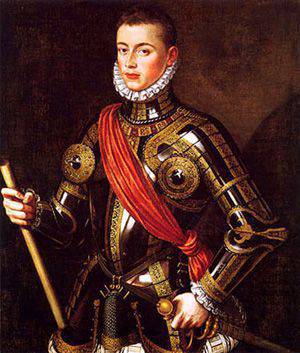
25 May 1571 in the Cathedral of St. Peter the representatives of Philip II, Pius V and the Venetian Doge signed a document on the establishment of the Holy League - a military-political alliance against the Ottoman Empire. The signatories pledged to deploy military contingents of a total of 200 galleys and 50 thous. Soldiers. The commander of the armed forces of the Holy League took over the king’s half-brother don Juan of Austria. It was decided that the first active actions would be taken in the summer of 1571.
Finals in Cyprus. "And the sea was boiling with a thousand oars." Fleet goes to sea
Around the middle of June, the Allied squadrons began to be in the port of Messina (Sicily). The Spanish contingent included galleys of Genoa, which were dependent on Spain. In September 1571, the Allies received news of the tragic end of the siege of the fortress of Famagusta that did not wait for help. Since spring, the Turks took this last stronghold of the Venetians on the island seriously. Pulling up the artillery, they launched a massive bombardment of the fortress, followed by two failed assaults. The defenders held out bravely, but by the end of the summer food supplies came to an end, by August the commandant of the garrison Marco Antonio Bragadino had no more than 500 combat-ready soldiers. The commander of the Turkish army, Mustafa Pasha, offered honorable conditions for surrender. But while signing the agreement, the Turks suddenly began a massacre, killing many Christians. Bragadino himself was betrayed by a painful death: skin was torn off him alive.
The news of the massacre in Famagusta enraged not only the Venetians, but the entire allied fleet. Now there is a more significant incentive than the papal proclamations, go to sea and get revenge. Don Juan of Austria became aware of the appearance of enemy ships in the southern sector of the Adriatic Sea. It was a matter of honor to go to sea and give battle.
September 16 Sacred League fleet left Messina. On September 27 he reached Corfu, whose governor reported that a Turkish fleet was seen from the island, which was heading south towards the port of Lepanto (Corinth Strait). Seeing that the battle is inevitable, don Juan conducts a redistribution of personnel from the approached transports. He reinforces the crews of Venetian galleys by Spanish and Genoese soldiers. This leads to friction between the allies - several people are hanged for fighting. The whole expedition is under threat. But thanks to the diplomatic talents of Marco Antonio Colonna, the commander of the papal squadron, manages to keep the situation under control. A brave but overly quick-tempered Sebastiano Venier, as commander of the Venetian squadron, replaces the more restrained 70-year-old Agostino Barbarigo. Soon, high-speed reconnaissance galleys reported that an enemy fleet had been spotted in the Gulf of Corinth.
The Turks, meanwhile, were in Lepanto, where the ships of Ali Pasha took on board for retrofitting 12 thousand people, mostly dismounted vultures - selective heavy cavalry. The flagship of Ali Pasha galera "Sultana" took on board 200 Janissaries. The Turkish commander received information about the approaching enemy, and on October 4 he gathers military advice. The problem was that Selim II, who imagines himself a grand strategist and a brilliant tactician, from Istanbul was incomparably better known how to fight the war properly. Therefore, he sent Ali Pasha a prescription "to search for meetings and fight the enemy." History shows that when incompetent and openly incompetent rulers register themselves in a club named after Caesar and Bonaparte, this always leads to disaster. The bigger the country, the bigger the disaster.
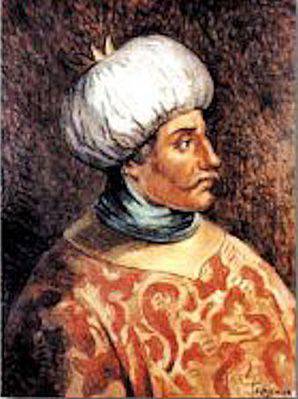
Opinions of the flagships of the Turkish fleet divided. The younger commander, cautious Mehemed Sulik Pasha (nicknamed Sirocco) rightly pointed out that autumn storms would soon begin and the allies would go to the bases, so you have to wait. The second flagship, who became skilled in the maneuver operations, was the commander of the Berber squadron, Uluj Ali Pasha, on the contrary, advocated the battle, for it was enough to go after the women of Lepanto. In the end, waving in front of those present with the sultan’s instructions, Ali Pasha announced that he had decided to give battle. The die was cast.
Crimson waves. Battle

On the morning of October 7 1571, approximately at 7 in the morning, opponents visually found each other. On that day, the Allied fleet had 206 galleys and 6 galeas. The latter were a kind of hybrid of sailing and rowing ship, were well armed and had large teams. The personnel of the Sacred League fleet consisted of more than 40 thousand sailors and crew members and 28 thousand soldiers boarding teams. The opposing Turkish fleet had 208 galleys, 56 Galiots and 64 fusts. The last two types are small vessels that were used to transfer personnel from ship to ship. On the ships there were approximately 50 thousand oarsmen and 27 thousand troops (including 10 thousand janissaries and 2 thousand sipahs). Most of the rowers in the Turkish galleys were slaves, and during the battle it was necessary to allocate soldiers to keep them in obedience. Ali Pasha’s ships on average had fewer cannons than their European opponents, among the Ottoman fighting teams there were more archers, and among the Europeans there were archebuses. In general, the Allied fleet had superiority in firepower.
For about two hours, the opponents spent building their battle formations. By analogy with land battles, the right and left wing, center and reserve were clearly identified. The disposition to the beginning of the case was as follows. The Allies left wing, resting on the coast, led Agostino Barbarigo (53 galleys, 2 galleas). The center was headed directly by Juan Austrian at the flagship Real Gallery (62 galleys, 2 Galleas). The left wing (53 galleys, 2 galleas) commanded Andea Doria. The rearguard, a reserve, included the 38 galleys flying the flag of Don Alvaro de Bazan. There also belonged intelligence from 8 high-speed galleries (Giovanni di Cardona).
The Turkish fleet shared the same way. The right flank consisted of 60 galleys, 2 Galiots under the leadership of Mehmed Sulik Pasha. Ali Pasha had 87 galleys - these were the main forces. And, finally, the left flank included the daring young men of Uluj Ali on the 67 galleys and the 32 haliots. Dragut Reis was on the rear with 8 small fleet galleys and 22 haloes.
By the morning 9 the construction was generally over. Fleets divided approximately 6 kilometers. Due to the rush caused by the desire of the Allied galleys to quickly take up positions in the ranks, the heavy galeasy people lagged behind and did not manage to advance to their positions ahead of the battle formations. The opposing fleets lined up front against each other. It soon became clear that the Turkish forces were hanging over both flanks of the Sacred League.
By order of their commanders, both the armada who had been prepared for battle began to draw closer. According to the testimony of the participants, it was a magnificent sight. Hundreds of ships, lined up in rows, went towards the battle - above the water came the measured creak of galley oars, clang weapons, shouts of commands and the rumble of drums, counting the rhythm for the rowers. Juan Austrian on the flagship "Real" ordered to fire a cannon to identify himself - he deliberately sought a meeting with the commander of the enemy. In response to the "Sultana" thundered a response shot. At this “gentleman's stage” of the battle began and ended. Ali Pasha, an excellent archer, took his place among the battle crew of his flagship. At about o'clock 10 in the morning the fleets were in the affected area by artillery fire. In the 10 hours of 20 minutes, one of the heavy galeas walking in front of the main forces opened fire. The third volley has already given a cover - one of the big galleries of the Turks got a hole and began to sink. In the middle of 11, the north wing of the Christian fleet was already engaging in battle. Two galleas, who were leading ahead of the galleria Barbarigo, like heavy riders, began to be screwed into the Turkish order, leading a constant fire on the Ottoman galleys trying to go around them. Story Mehmed Sulik Pasha mixed. Considering that the frontal attack will not be sufficiently effective, he begins to make a roundabout maneuver with a part of his forces, trying to go around the enemy along the coast. A desperate dump began, its center was the flagship lanterna (heavy galley) Barbarigo, which was attacked by five galleys of the Turks. The brave old man led the battle, sitting at the mainmast, until he raised his helmet visor to give another order. At that moment, an arrow hit him in the eye. Seriously wounded Barbarigo carried to the hold. Seeing the wound of his commander, the team hesitated, but at that moment the galleys from the reserve approached, and the Turks managed to repel the onslaught. The flank maneuver of Mehmed Sulik-pasha was at first quite successful and created a threat to reach the flank of the Christians, but one of the younger commanders of Barbarigo, who took command, Marco Quirini made a bold decision to bypass the enemy who made the rounds and hit back. This maneuver on the environment surrounding has led to success - the Turkish galleys were pressed against the shoals of the marshy coast and were under the dense fire of the forces of the Sacred League. Crews began to massively throw their ships and tried to swim to the shore. Many galleys rebelled Christian slaves, which hastened the end of the Turkish right flank. By one o'clock it was practically destroyed - hundreds of Turks were captured, including the heavily burned Sirocco Mehmed Sulik Pasha.
In the center, after “gentleman’s shots”, the main forces in 11 watches began to exchange volleys, reducing the distance. And then the Venetian galeasy fairly spoiled the Turks harmony ranks. Ali Pasha was forced to even order to slow down the course in order to align their orders. The flagship Real and Sultan came closer and closer to each other. Around both commanders were the largest galleys with large crews, because it was clear that there would be the epicenter of the battle. In 11.40, the flagships came together in a boarding battle: the Christians were firing arquebuses, the Turks responded with a shower of arrows. Selected janissaries rushed into the attack on the deck of Real Madrid, but they were also met by selected Spanish infantry. Again, the Toledo steel resumed its dispute with damask damask steel. The Turks managed to take a forecastle, but they did not move further. All new galleys approached the coupled flagships on both sides, seeking to provide support. Soon it was already a tangle of almost 30 ships, on the decks of which desperate battles took place. Low-tonnage Turkish galibies and maneuverable fusts tried to transfer reinforcements from the reserve to the galleys fighting around the Sultans. Similar actions were carried out by Christians. Don Alvaro de Bazan threw reserves in reserve in an extreme case. The Spaniards, who received reinforcements, cleared the Real's deck of the Turks by noon and the battle moved to the Sultan. In the midst of the merciless battle of the Captain gallery, Marco Antonio Colonna was able to break through to the Turkish flagship and crash into his stern. The crew of the Turkish flagship fought desperately, Ali Pasha himself shot from a bow like a simple warrior. But by one o'clock the Sultan was captured - Ali Pasha was killed in battle. According to one of the versions, they cut off his head and threw him on a pike. The capture of the flagship depressingly affected the Turkish main forces, the resistance of the Ottomans begins to weaken. Story collapsed - began a disorderly retreat. By half past one, the center of the Turkish fleet was completely destroyed.
Interesting activities took place in the south, where the desperate maritime cutters, professionals of their work, Andrea Doria and Uluj Ali met. The Berbury Admiral was a man with a biography. By origin an Italian, Giovanni Dirnidzhi Galeni 17-year-old youth was captured by pirates, converted to Islam and made a brilliant career, reaching the governor of Algeria. The Italian was not inferior in experience to his counterpart. With the beginning of the battle, Uluj Ali sought to bypass the left flank of the Christians to strike them from the rear - most of the Turkish galleys here were small, high-speed ships of the Berber pirates. Doria, in order not to be bypassed, was forced to repeat the maneuver of her opponent. Both wings broke away from their main forces. In 12 hours, realizing that it will not be possible to bypass the Italian, Uluj Ali orders his forces to turn to the north-west in order to enter the resulting gap between the center and the right wing of the Christian fleet. Andrea Doria immediately discharges 16's most high-speed galleys under the command of Giovanni di Cardona to prevent this maneuver. Seeing the separation of the forces of his opponent, Uluj Ali collapses with all his ships on Cardona. Berbers began to take up. Uluj Ali embarked a fiercely resisting galera of Maltese knights and eventually captured her. Andrea Doria’s approach to the main forces and the enormous Andrea de Cesaro’s galleas, who supported their fires, saved them from total destruction. Uluj Ali left the bulk of his forces to fight with Doria, while he himself with the 30 galleys went to help Ali Pasha. But it was too late. The flagship was killed, the Turkish center was broken. At the cost of enormous losses, the Cardonne Detachment fulfilled its task - distracted the Berbers. The private success of Uluj Ali has already decided nothing. He ordered his ships to retreat. As a consolation prize, the corsair took in tow a Maltese gallera, captured by him, which, however, had to be abandoned soon. To “troll” his opponents, Uluj Ali tied the Maltese flag to the mast of his flagship. However, the battle was hopelessly lost. Around 30, high-speed galleys managed to escape with the Berber admiral, who left the battlefield at around 14 hours. The battle lasted about an hour more, but it was more like finishing off an already defeated enemy. In the heat of battle, don Juan wanted to pursue Uluj Ali, but his flagships reported large ship damage and losses. The Christians were tired of the battle, which lasted almost 4 hours.
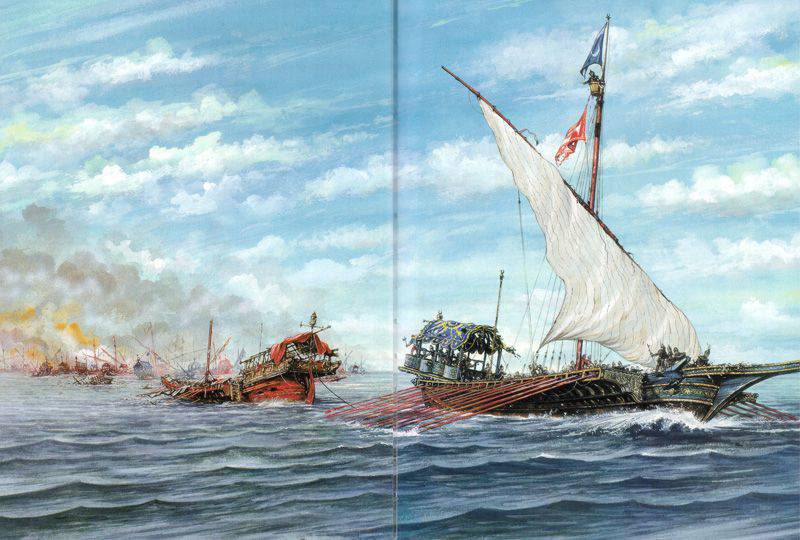
The Turkish fleet was completely crushed. The 170 ships became the trophies of the Holy League. The losses of the Turks in the staff amounted to almost 30 thousands of people. The prisoners were taken reluctantly - there were no more than 3000. 15 of thousands of Christian slaves were freed. The holy league lost 10 galleys, 10 thousand killed, 21 thousand people were injured. The Allied fleet was able to leave the battlefield only with the help of the liberated rowers. Seriously wounded, Cirocco Mehmed Sulik Pasha asked to be shot to save him from torment, and the winners generously fulfilled his request. His opponent, also badly wounded, Barbarigo, having learned about the victory, died after tormenting himself. October 9 don Juan ordered to move north. The 23 of October, filled with moaning wounded ships of the Christian fleet, arrived in Corfu, where the winners were divided: the Venetians went north and the rest of the forces went to Messina.
No one counted how many wounded died along the way at the then level of medicine.
Coalition at the Broken Trough
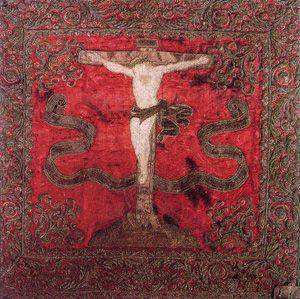
Standart Don Juan of Austria
Lepanto's brilliant victory did not lead to anything. The destruction of the fleet was for the Ottoman Empire a painful, but not fatal blow. Returning to Istanbul, Uluj Ali told Selim II his version of the events that took place, after which he was treated kindly, appointed a hero and was given the post of fleet commander, who was soon rebuilt with success. In May 1572, the main ideologue of the Holy League, Pius V, died, and its members lost their inspiration and interest in this political enterprise. Juan Austrian concentrated his efforts on operations against Tunisia, which he managed to recapture in the same 1573 year, but next year, 1574, Uluj Ali will return him no less successfully. Spain was more interested in the problems in the Netherlands and the actions of the English pirates than the fuss in the eastern Mediterranean. Left virtually alone with the Ottoman Empire, Venice was forced to sign the peace proposed by the Turks. She gave up her rights to Cyprus and was to pay the sultan on 300 thousands of ducats for three years. The signing of the world caused a storm of indignation in Spain, which is increasingly tied up in the confrontation with England. In Madrid, they believed that Venice had treacherously surrendered all the results of the victory at Lepanto, while the Spaniards themselves no longer wanted to fight the Turks. Selim II nicknamed "Drunkard" briefly outlived his enemy, Pius V-15 December, he died in the harem of Topkapi Palace. Fatherly fame from never earned.
Almost 500 years have passed since the time of the largest Renaissance battle at Lepanto. The gallery as a class ship will be actively used for another two and a half centuries. The thunder of Gangut and Grengam, the First and Second Rochesalmskim battles has not yet sounded.
Archaeological investigations at the site of the battle of Lepanto are not conducted due to restrictions imposed by the Greek government. No one is disturbing the peace of thousands of Muslim and Christian soldiers who have found their last refuge at the bottom of the sea. Time and waves reconciled the dead, but not the living.
Information